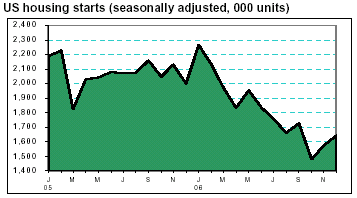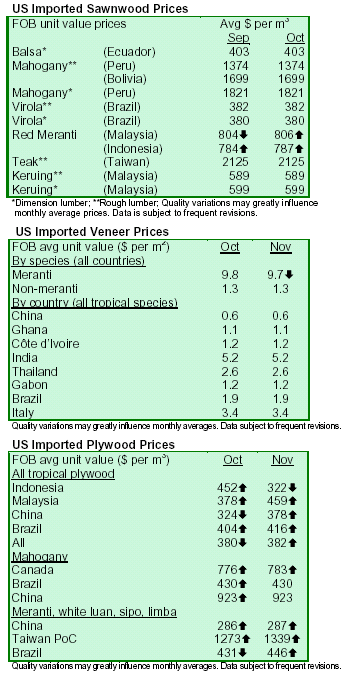|
US housing starts recover again in December
Privately-owned housing starts recovered 4.5% again in December to a seasonally adjusted annual rate of 1.64
million units, according to the US Commerce Department. This was, however, 18% below the pace of a year ago. The
recovery was despite a 4.5% drop in the single-family sector, which accounts for about 80% of the houses built.
The chart below shows that privately-owned housing starts have plunged 28% since January 2006. Meanwhile,
building permits (up 5.5% from November) and housing completions (up 0.4%) surged in December. An estimated
1.8 million housing units were started in 2006, down 12.9% from 2005. The forecast for 2007 is 1.5 million
units, down 16.7% from 2006.

China regrets US trade complaint at the WTO
China expressed regret at US decision to file a complaint against it at the WTO over alleged improper subsidies to
Chinese exporters. The WTO filing by the Bush administration follows pressure from the Democratic
party-controlled Congress for action to address record annual trade deficits with China. The filing alleges that
China uses tax and other tools to encourage exports and to discriminate against imports of a variety of
US manufactured goods. Susan Schwab, US trade representative, said the move came after efforts at dialogue
failed. She said the subsidies at issue were offered across the spectrum of industry sectors in China, whether in steel,
wood products, information technology or others.
The USA announcement did not give details of the policies it found objectionable, but these are likely to
include use of business income tax incentives and the provision of cheap loans for
exporters. Last month, the US Trade Representative and the Department of Commerce
accused China of delayed and incomplete notification of its subsidy programmes. They said that although China
notified over 70 subsidy programmes, it failed to notify any subsidies provided by China's state-owned banks or by
provincial and local government authorities, and did not make any effort to withdraw several subsidies that appear
to be prohibited. China has up to three months to respond before the creation of a WTO panel to hear the complaint.
Shifts in the North American industrial panel markets
In this second article, the changing competitive position of wooden panels (particleboard, MDF and hardboard) and
North American producers is analyzed.
The USA takes the lion share in panel production
The different developments in the US, Canadian and Mexican panel industries led to a
repositioning of market shares within North America. Clearly, the USA holds the
largest market share for all three industrial panel categories in terms of production. It is over 90% for
hardboard and around 70% for particleboard and MDF. The USA was also able to strengthen its position in North
America between 2005 and 2006. The USA increased its share particularly in
particleboard, which went up from 64.4% in 2005 to 71% last year (see chart). The increases
in MDF and hardboard were less pronounced, from 69.1% to 69.2% and from 91.3% to 91.4%, respectively.
Canada has a relatively strong and stable MDF industry, which accounted for 30.2% of the North American
production capacity in 2005 and 2006. However, Canada¡¯s particleboard and
hardboard production shares fell from 28.8% to 22% (see chart) and from 8.7% to 8.6%,
respectively. In Mexico, only the particleboard industry is of some international relevance.
Mexico increased its share moderately from 6.8% in 2005 to 7% last year (see
chart).

MDF challenges particleboard¡¯s market share
Particleboard is the largest product category within the industrial wooden panels while MDF is the fastest
growing product. The dominating position of particleboard has continued to be encroached by MDF. In 2005,
particleboard, MDF and hardboard accounted for 64.7%, 27% and 8.3% of the North American industrial capacity,
respectively. In 2006, these shares changed to 62.9%, 28.7% and 8.4%, respectively. The shift away from
particleboard to MDF was particularly pronounced in Canada, where particleboard¡¯s share fell from 67.7% to
59.6% while MDF¡¯s share rose from 29.7% to 37.3%, during the period under review.
Surprisingly, the USA is bucking the North American trend. Particleboard capacity made some modest headways
in absolute and relative terms in this country in spite of a deteriorating
capacity utilization rate. US particleboard¡¯s share advanced from 61.3% to 61.8%, MDF¡¯s share
remained unchanged at 27.5% and hardboard fell from 11.2% to 10.7%.

¡¡
|